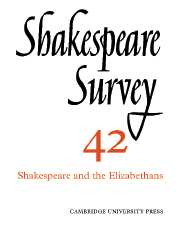Book contents
- Frontmatter
- ‘Jack hath not Jill’: Failed Courtship in Lyly and Shakespeare
- Truth and Art in History Plays
- Chronicles and Mythmaking in Shakespeare’s Joan of Arc
- King John and Embarrassing Women
- Golding’s Ovid, Shakespeare’s ‘Small Latin’, and the Real Object of Mockery in ‘Pyramus and Thisbe’
- Ovid and the Sonnets; or, did Shakespeare Feel the Anxiety of Influence?
- The Play of Sir Thomas More and Some Contemporary Events
- ‘Nobody’s Perfect’: Actors’ Memories and Shakespeare’s Plays of the 1590s
- The Boyhood of Shakespeare’s Heroines
- Shakespeare’s ‘Brawl Ridiculous’
- Shakespeare’s Handwriting
- Shakespeare Performances in England, 1987–8
- Professional Shakespeare Productions in the British Isles, January-December 1987
- The Year's Contributions to Shakespearian Study 1 Critical Studies
- 2 Shakespeare’s Life, Times, and Stage
- 3 Editions and Textual Studies
- Books Received
- Index
‘Jack hath not Jill’: Failed Courtship in Lyly and Shakespeare
Published online by Cambridge University Press: 28 March 2007
- Frontmatter
- ‘Jack hath not Jill’: Failed Courtship in Lyly and Shakespeare
- Truth and Art in History Plays
- Chronicles and Mythmaking in Shakespeare’s Joan of Arc
- King John and Embarrassing Women
- Golding’s Ovid, Shakespeare’s ‘Small Latin’, and the Real Object of Mockery in ‘Pyramus and Thisbe’
- Ovid and the Sonnets; or, did Shakespeare Feel the Anxiety of Influence?
- The Play of Sir Thomas More and Some Contemporary Events
- ‘Nobody’s Perfect’: Actors’ Memories and Shakespeare’s Plays of the 1590s
- The Boyhood of Shakespeare’s Heroines
- Shakespeare’s ‘Brawl Ridiculous’
- Shakespeare’s Handwriting
- Shakespeare Performances in England, 1987–8
- Professional Shakespeare Productions in the British Isles, January-December 1987
- The Year's Contributions to Shakespearian Study 1 Critical Studies
- 2 Shakespeare’s Life, Times, and Stage
- 3 Editions and Textual Studies
- Books Received
- Index
Summary
I begin with two perceptions: first, the observation of Robert Y. Turner that English comedy did not really find a successful way to dramatize love in any psychological sense before Lyly began his career as a playwright, and second, that of Alfred Harbage and others that Love’s Labour’s Lost is the most Lylyan of Shakespeare’s plays. The Lyly play that immediately invites attention in this regard is Sappho and Phao, written in 1584, since, like Shakespeare’s Love’s Labour’s Lost, it ends in a lack of romantic completion for the young lovers. Without wishing to argue that Shakespeare turned directly to Sappho and Phao as a kind of source, I should like to ask what we can learn from examining these two plays together. They are both centred on the experience of young men and women as they meet one another for the first time in amorous encounter, and in both plays the experience is a difficult one, evoking in the men sensations of apprehension, curiosity, fascination of course but also diminished self-regard and humiliation, all leading ultimately to a collapse or at least postponement of the negotiations in love. Both plays feature a princess or queen whose independence and regal self-assurance inspire an outspokenness in the women around her that the men find, in varying degrees, threatening.
- Type
- Chapter
- Information
- Shakespeare Survey , pp. 1 - 14Publisher: Cambridge University PressPrint publication year: 1990

